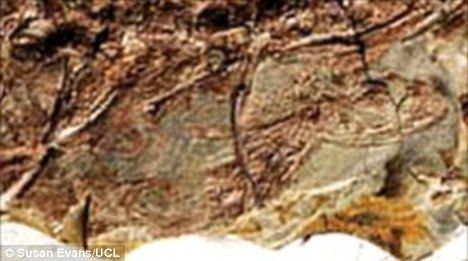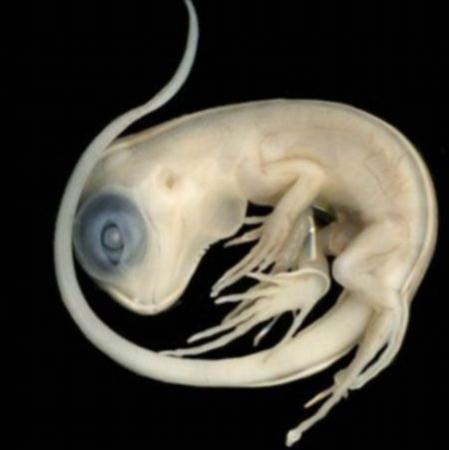摘要:科学家在中国东北部发现年代最为久远的怀孕蜥蜴的化石,距今至少1.2亿年。这块怀孕蜥蜴化石的发现证明,白垩纪早期的一些蜥蜴和蛇类也通过分娩的方式繁殖下一代,而不是产卵,远远早于此前的预计。
这位长腿蜥蜴妈妈在分娩前几天就死亡,而后被埋入泥浆中变成化石。它可能生活在溪流沿岸,体内蜥蜴胎儿超过15个。这一发现由英国伦敦大学学院和北京中国科学院的科学家得出,研究论文刊登在《自然科学》(Naturwissenschaften)期刊上。在此之前,科学家只发现怀孕海生蜥蜴的化石。伦敦大学学院细胞与发育生物学系教授苏珊-埃文斯表示:“我不认为自己此前曾见过很多类似的化石。”
中国科学院的王原(Yuan Wang,音译)在对化石进行分析时,发现了至少15个几乎已完全发育成熟的胚胎遗迹。他说:“在利用显微镜进行观察时,我发现了这些小胚胎。提到分娩,绝大多数人认为只有哺乳动物才会采取这种方式,实际上,大约有20%的蜥蜴和蛇类也采取分娩的方式繁殖下一代,而不是产卵。我们此前认为蜥蜴在哺乳动物出现后采取这种方式,现在看来,可能与哺乳动物出现的时间大致相同。这是我们见过的最古老的怀孕蜥蜴化石,说明为胚胎提供充足的供血、很薄的壳或者完全没有壳等生理适应特征很早便已经进化出来。”
化石是在中国东北部的热河地区发现的,当地的石灰岩遭侵蚀后逐渐暴露出数百个化石,其中包括恐龙、鱼类、两栖类、爬行类、鸟类、哺乳类、无脊椎类动物以及一系列植物。此次发现的蜥蜴是小矢部龙家族成员,这是一种大型原始蜥蜴,与现代壁虎类似。从产卵到分娩的转变往往与寒冷而危险的环境有关,在这种环境下,卵不可能幸存下来。
采取分娩方式付出的代价是,蜥蜴母亲怀孕期间体重增加,限制了它们的移动和自我保护能力。埃文斯表示:“我们知道这只蜥蜴生活在水边,我们认为它可能在水中活动,虽然最初生活在陆地上。对于怀孕的蜥蜴来说,这能提高自身的保护能力,如果附近出现恐龙,它可以逃进水里。”

裂开的石灰岩,暴露出小矢部龙化石

蜥蜴胚胎的形状在母亲的骨骼中间依稀可见

鬣蜥胚胎,所处发育阶段与化石中发现的小矢部龙胚胎类似
生物探索推荐英文论文摘要:
NATURWISSENSCHAFTEN
DOI: 10.1007/s00114-011-0820-1
A gravid lizard from the Cretaceous of China and the early history of squamate viviparity
Abstract
Although viviparity is most often associated with mammals, roughly one fifth of extant squamate reptiles give birth to live young. Phylogenetic analyses indicate that the trait evolved more than 100 times within Squamata, a frequency greater than that of all other vertebrate clades combined. However, there is debate as to the antiquity of the trait and, until now, the only direct fossil evidence of squamate viviparity was in Late Cretaceous mosasauroids, specialised marine lizards without modern equivalents. Here, we document viviparity in a specimen of a more generalised lizard, Yabeinosaurus, from the Early Cretaceous of China. The gravid female contains more than 15 young at a level of skeletal development corresponding to that of late embryos of living viviparous lizards. This specimen documents the first occurrence of viviparity in a fossil reptile that was largely terrestrial in life, and extends the temporal distribution of the trait in squamates by at least 30 Ma. As Yabeinosaurus occupies a relatively basal position within crown-group squamates, it suggests that the anatomical and physiological preconditions for viviparity arose early within Squamata.







